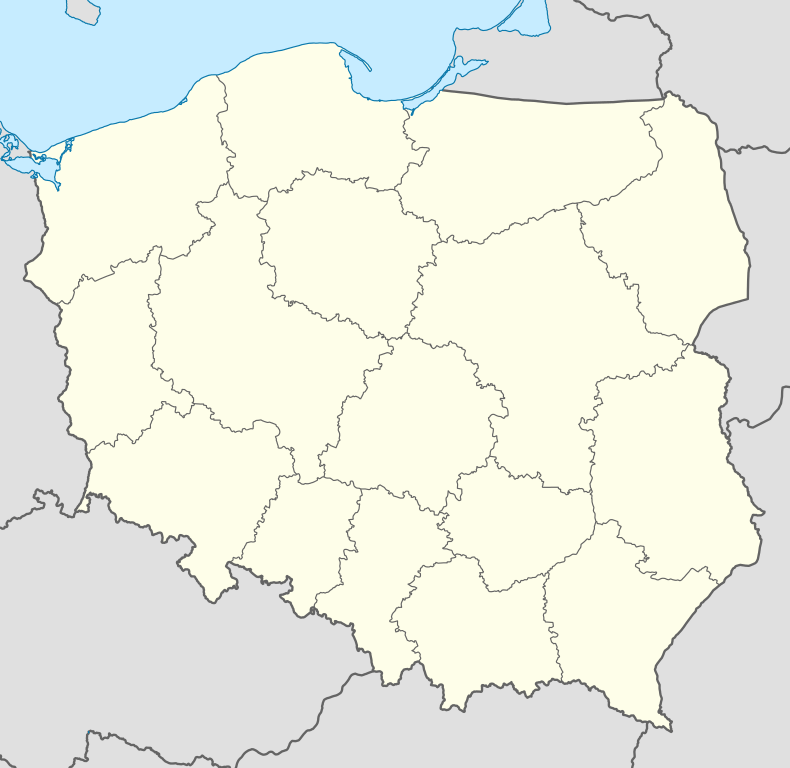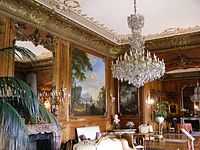Pszczyna Castle
| Pszczyna Castle Zamek w Pszczynie (Polish) | |
|---|---|
|
| |
| Location |
ul. Brama Wybranców 1 43-200 Pszczyna |
| Coordinates | 49°58′41″N 18°56′25″E / 49.97806°N 18.94028°ECoordinates: 49°58′41″N 18°56′25″E / 49.97806°N 18.94028°E |
| Elevation | 242 m |
| Built | 12th century |
| Rebuilt | 15th century, 16th century, 1734–1768, 1870–1876 |
| Architect | 1870-1876: Hippolyte Alexandre Destailleur |
| Architectural style(s) | Baroque Revival architecture |
| Designated | 07.02.1966 |
| Reference no. | 535/65 |
 Location of Pszczyna Castle Zamek w Pszczynie (Polish) in Poland | |
Pszczyna Castle (Polish: Zamek w Pszczynie) is a classical-style palace in the city of Pszczyna (German: Pless). Constructed as a castle in 13th century or earlier, in a gothic style, it was rebuilt in a renaissance style in the 17th century. During the course of the 18th and 19th centuries, the exterior of the castle was partially changed into a baroque-classic style. The classicist modernization transformed the castle into what is usually described a palace.
In its history the castle was a residence of Silesian Piast nobles, then Promnitz family members (mid-16th to mid-18th centuries) and later the von Pless family. The castle has been state-owned since 1936. In 1946 it was designated a muzeum zamkowe (castle museum).
In 2009 it was voted as one of the "Seven Architectural Wonders of the Silesian Voivodeship" by Silesian authorities. [1]
History
Early the Middle Ages, Pszczyna was a stronghold of the Piast dukes of Poland. The city belonged to Lesser Poland (Malopolska) until 1177, when it became part of the Duchy of Racibórz. From this time on, it also was part of the Bishopric of Kraków. In 1548, the palace was sold to the noble Promnitz family of Saxony and given a Renaissance appearance, which it lost after a fire. It was subsequently rebuilt in a more baroque style.
In 1705, Baroque composer Georg Philipp Telemann became Kapellmeister to Erdmann II of Promnitz, privy councillor to Augustus II the Strong, elector of Saxony and king of Poland, and spent considerable time at Pless Palace when the latter's court summered there. This gave Telemann an opportunity to study Polish and Moravian folk music, which fascinated and inspired him.
In 1742 Pless became part of Brandenburg-Prussia. In 1848 the Duchy of Pszczyna became a Principality, ruled by the Hochberg-Fürstenstein family until 1939. Between 1870 and 1876, reconstruction of the palace was directed by the French architect Gabriel-Hippolyte Destailleur.
During the First World War, the palace, then in Germany, at times hosted William II, German Emperor, and there are pictures on display of him together with Erich Ludendorff and Paul von Hindenburg discussing miitary operations. After the war and a plebiscite in 1921, the town became part of Poland. It was occupied by the Germans in 1939.
After the Second World War, Upper Silesia became Polish. For a brief period there was a Soviet military hospital in the palace, but in May 1946 it was turned into a museum.
Interior

The Royal Apartments, or Apartamenty Cesarskie, are the rooms in which the rulers of the principality and the German Kaiser resided. They have been recreated with a lot of the original furnishings intact.
When ascending the Grand Staircase, designed by Alexandre Destailleur, the apartments of Princess Mary Theresa Olivia Cornwallis-West von Pless are reached. The princess, called Daisy, lived there from 1891, when she married Prince Hans Heinrich XV and left her native England, until 1943. The rooms are decorated with pictures of the princess and hunting trophies of her husband.
The highlight of the palace is its Chamber of Mirrors. An art nouveau dining room is another place of interest.
See also
External links
| Wikimedia Commons has media related to Pszczyna Palace. |
References
- ↑ "Znamy 7 cudów architektury województwa śląskiego". Slaskie.pl. 2009-10-09. Retrieved 2014-03-07.